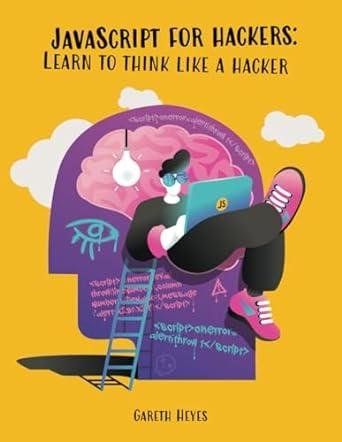JavaScript for Hackers: Learn to Think Like a Hacker
In the world of cybersecurity, the ability to think like a hacker is a valuable skill. "JavaScript for Hackers: Learn to Think Like a Hacker" is a comprehensive guide that not only teaches you JavaScript but also how to use it with a hacker's mindset. This book provides an in-depth understanding of JavaScript’s capabilities and its potential for both security and exploitation. Whether you’re a developer looking to protect your code or an aspiring ethical hacker, this book is an essential resource.
Chapter 1: Introduction to JavaScript
JavaScript is a versatile programming language that powers much of the web. Its flexibility and ease of use make it a favorite among developers. However, these same qualities also make it a target for malicious hackers. Understanding the basics of JavaScript is the first step towards mastering its use in both offensive and defensive capacities.
Chapter 2: JavaScript Fundamentals
Before diving into hacking techniques, a solid understanding of JavaScript fundamentals is necessary. This chapter covers the basics, including variables, data types, functions, and control structures. By mastering these concepts, you’ll have the foundation needed to explore more advanced topics.
Variables and Data Types
JavaScript’s dynamic nature allows for flexibility in variable declaration and usage. Understanding the different data types and how they interact is crucial for writing effective code.
Functions and Control Structures
Functions are the building blocks of JavaScript. This section explores how to write and utilize functions efficiently. Additionally, control structures such as loops and conditionals are discussed in detail, providing the tools needed to create complex programs.
Chapter 3: Advanced JavaScript Techniques
With the basics covered, it's time to delve into more advanced topics. This chapter introduces concepts such as closures, promises, and asynchronous programming. These techniques are not only useful for everyday programming but also essential for understanding and exploiting security vulnerabilities.
Closures and Scope
Closures are a powerful feature of JavaScript, allowing functions to retain access to their scope even after they have executed. Understanding closures is key to mastering JavaScript.
Promises and Asynchronous Programming
Asynchronous programming is a core aspect of modern JavaScript development. This section covers the use of promises and async/await, enabling you to write efficient, non-blocking code.
Chapter 4: The Hacker’s Mindset
Thinking like a hacker involves understanding how systems can be exploited. This chapter provides insights into the hacker’s mindset, exploring common tactics and methodologies used to find and exploit vulnerabilities.
Reconnaissance
The first step in any hacking attempt is reconnaissance. This involves gathering information about the target system. Techniques such as web scraping and API interrogation are covered in this section.
Exploitation Techniques
Once vulnerabilities are identified, the next step is exploitation. This section discusses common exploitation techniques, including cross-site scripting (XSS) and cross-site request forgery (CSRF).
Chapter 5: Defensive JavaScript
Understanding how to defend against attacks is just as important as knowing how to execute them. This chapter focuses on writing secure JavaScript code, covering best practices and common pitfalls.
Input Validation
One of the most effective ways to prevent attacks is through proper input validation. This section covers techniques for validating user input to prevent common attacks such as SQL injection and XSS.
Secure Coding Practices
Writing secure code involves following best practices and avoiding common pitfalls. This section provides a comprehensive overview of secure coding practices for JavaScript developers.
Chapter 6: Real-World Hacking Scenarios
Applying your knowledge to real-world scenarios is the best way to solidify your understanding. This chapter presents a series of practical hacking scenarios, challenging you to think like a hacker and find vulnerabilities in sample applications.
Scenario 1: Web Application Penetration Testing
This scenario involves testing a web application for common vulnerabilities. You’ll use the techniques learned in previous chapters to identify and exploit weaknesses.
Scenario 2: JavaScript-Based Malware
In this scenario, you’ll explore how JavaScript can be used to create malware. By understanding how malicious code is written, you’ll be better equipped to defend against it.
Chapter 7: Ethical Hacking and the Law
Ethical hacking is about finding and fixing vulnerabilities before they can be exploited by malicious hackers. This chapter covers the ethical and legal considerations of hacking, providing guidance on how to conduct yourself responsibly and legally.
The Ethics of Hacking
Understanding the ethical implications of hacking is crucial. This section explores the responsibilities of an ethical hacker and the importance of responsible disclosure.
Legal Considerations
Hacking can have serious legal consequences. This section provides an overview of the legal landscape, helping you understand the potential risks and how to navigate them.
Chapter 8: Tools and Resources
Having the right tools and resources is essential for any hacker. This chapter provides an overview of the most commonly used tools in the industry, as well as resources for further learning.
JavaScript Libraries and Frameworks
Libraries and frameworks can simplify JavaScript development and provide additional functionality. This section covers popular libraries such as jQuery and frameworks like Node.js.
Hacking Tools
There are many tools available to assist with hacking and penetration testing. This section provides an overview of essential tools, including browser extensions and standalone applications.
Conclusion
"JavaScript for Hackers: Learn to Think Like a Hacker" is a comprehensive guide that bridges the gap between development and cybersecurity. By understanding how hackers think and operate, you can better protect your code and systems from malicious attacks. Whether you’re a developer looking to enhance your security knowledge or an aspiring ethical hacker, this book provides the tools and knowledge needed to succeed.
In summary, this book covers the full spectrum of JavaScript and hacking, from the basics of the language to advanced exploitation techniques. With practical scenarios and a focus on ethical hacking, "JavaScript for Hackers: Learn to Think Like a Hacker" is an invaluable resource for anyone looking to master JavaScript from a security perspective.
